PROJ6009: Business Process Management Systems Analysis and Improvement
VerifiedAdded on 2022/07/28
|12
|2291
|21
Report
AI Summary
This report presents a comprehensive analysis of business process management (BPM) systems within the context of a real estate leasing scenario in Melbourne, Australia. The report begins by evaluating the existing 'as-is' process and identifies areas for improvement, primarily focusing on customer satisfaction as the key performance indicator. It then proposes a new 'to-be' process, streamlining the steps involved in leasing a house. The report details an audit process, including feedback from agents, purchasers, and sellers, to assess the effectiveness of the new model. A comparison is made between the 'as-is' and 'to-be' processes, emphasizing the reduction in complexity and time. The report further assesses whether the 'to-be' process can be converted into a 'should-be' process, considering resource and capability comparisons. It outlines a governance process for BPM change, detailing steps from process planning and strategy to performance evaluation, and emphasizes the importance of stakeholder consideration throughout the process. The conclusion highlights the significance of adapting business processes to meet customer needs and the expected positive impact of the new model based on customer feedback.
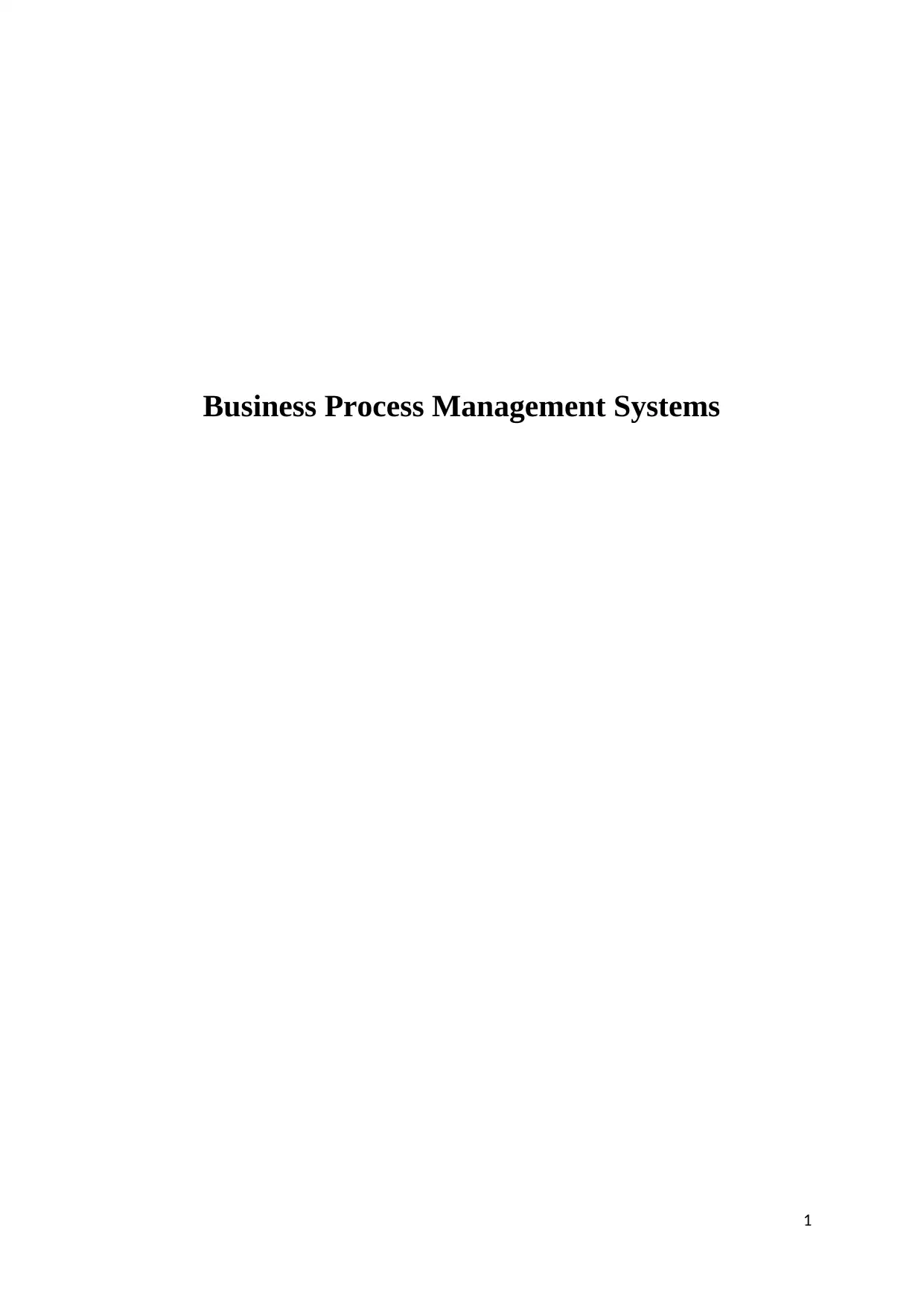
Business Process Management Systems
1
1
Paraphrase This Document
Need a fresh take? Get an instant paraphrase of this document with our AI Paraphraser

Contents
Introduction...........................................................................................................................................3
Audit process and improvement methods..............................................................................................4
Can "to be" process converted into "should be".....................................................................................6
Governance process for BPM change....................................................................................................7
Consideration of stakeholders in the new process.................................................................................8
Conclusion...........................................................................................................................................10
References...........................................................................................................................................11
2
Introduction...........................................................................................................................................3
Audit process and improvement methods..............................................................................................4
Can "to be" process converted into "should be".....................................................................................6
Governance process for BPM change....................................................................................................7
Consideration of stakeholders in the new process.................................................................................8
Conclusion...........................................................................................................................................10
References...........................................................................................................................................11
2
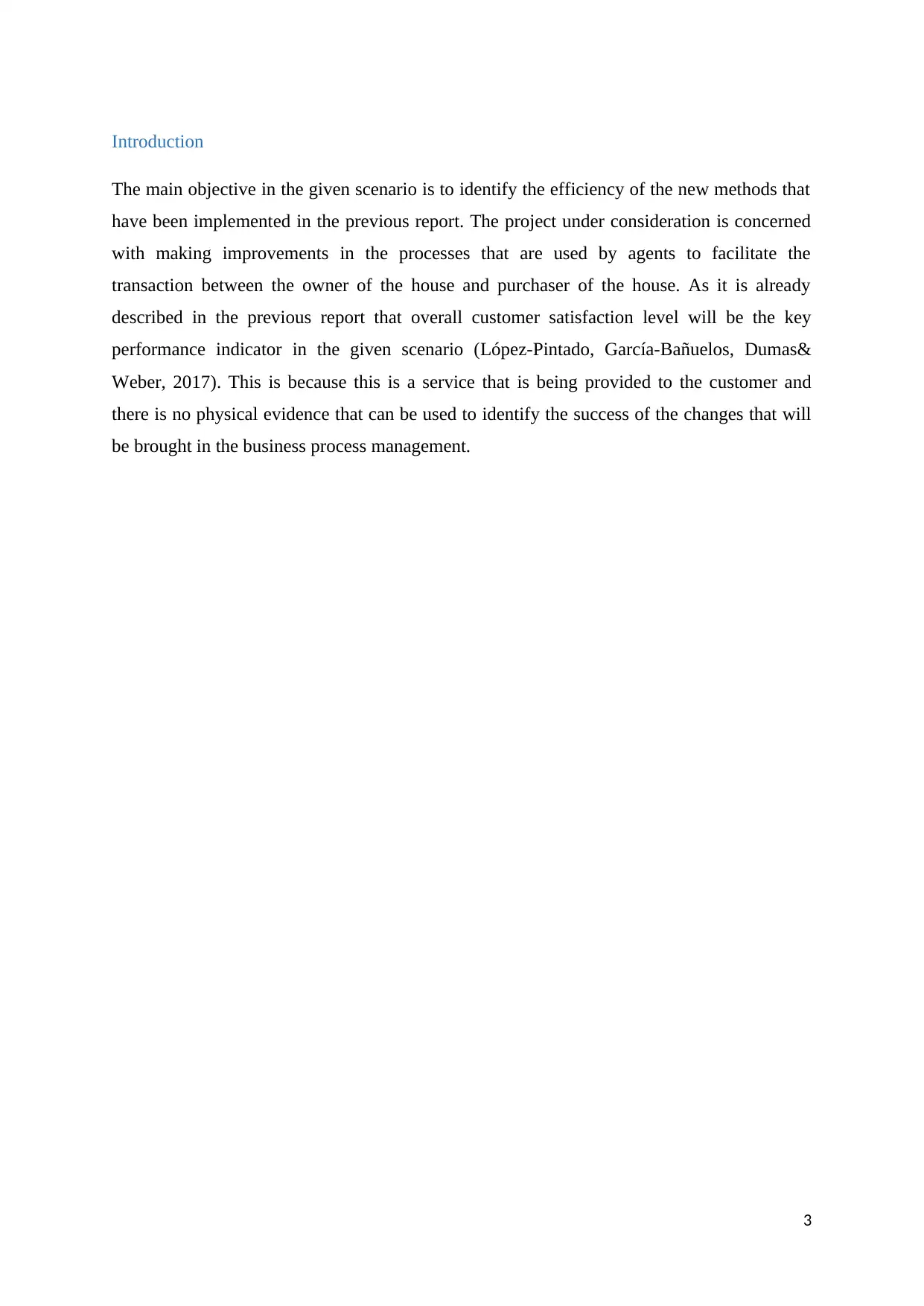
Introduction
The main objective in the given scenario is to identify the efficiency of the new methods that
have been implemented in the previous report. The project under consideration is concerned
with making improvements in the processes that are used by agents to facilitate the
transaction between the owner of the house and purchaser of the house. As it is already
described in the previous report that overall customer satisfaction level will be the key
performance indicator in the given scenario (López-Pintado, García-Bañuelos, Dumas&
Weber, 2017). This is because this is a service that is being provided to the customer and
there is no physical evidence that can be used to identify the success of the changes that will
be brought in the business process management.
3
The main objective in the given scenario is to identify the efficiency of the new methods that
have been implemented in the previous report. The project under consideration is concerned
with making improvements in the processes that are used by agents to facilitate the
transaction between the owner of the house and purchaser of the house. As it is already
described in the previous report that overall customer satisfaction level will be the key
performance indicator in the given scenario (López-Pintado, García-Bañuelos, Dumas&
Weber, 2017). This is because this is a service that is being provided to the customer and
there is no physical evidence that can be used to identify the success of the changes that will
be brought in the business process management.
3
⊘ This is a preview!⊘
Do you want full access?
Subscribe today to unlock all pages.

Trusted by 1+ million students worldwide
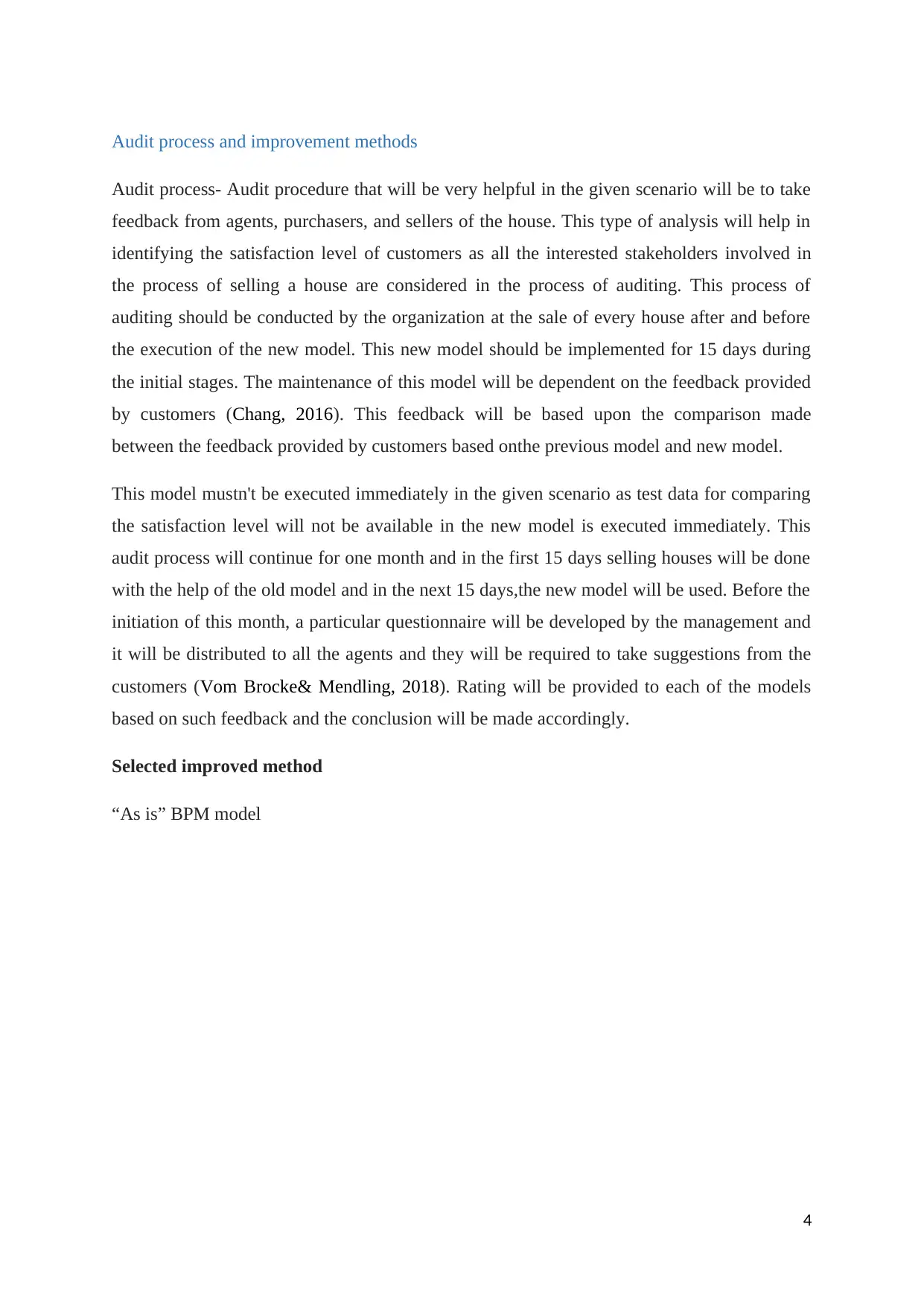
Audit process and improvement methods
Audit process- Audit procedure that will be very helpful in the given scenario will be to take
feedback from agents, purchasers, and sellers of the house. This type of analysis will help in
identifying the satisfaction level of customers as all the interested stakeholders involved in
the process of selling a house are considered in the process of auditing. This process of
auditing should be conducted by the organization at the sale of every house after and before
the execution of the new model. This new model should be implemented for 15 days during
the initial stages. The maintenance of this model will be dependent on the feedback provided
by customers (Chang, 2016). This feedback will be based upon the comparison made
between the feedback provided by customers based onthe previous model and new model.
This model mustn't be executed immediately in the given scenario as test data for comparing
the satisfaction level will not be available in the new model is executed immediately. This
audit process will continue for one month and in the first 15 days selling houses will be done
with the help of the old model and in the next 15 days,the new model will be used. Before the
initiation of this month, a particular questionnaire will be developed by the management and
it will be distributed to all the agents and they will be required to take suggestions from the
customers (Vom Brocke& Mendling, 2018). Rating will be provided to each of the models
based on such feedback and the conclusion will be made accordingly.
Selected improved method
“As is” BPM model
4
Audit process- Audit procedure that will be very helpful in the given scenario will be to take
feedback from agents, purchasers, and sellers of the house. This type of analysis will help in
identifying the satisfaction level of customers as all the interested stakeholders involved in
the process of selling a house are considered in the process of auditing. This process of
auditing should be conducted by the organization at the sale of every house after and before
the execution of the new model. This new model should be implemented for 15 days during
the initial stages. The maintenance of this model will be dependent on the feedback provided
by customers (Chang, 2016). This feedback will be based upon the comparison made
between the feedback provided by customers based onthe previous model and new model.
This model mustn't be executed immediately in the given scenario as test data for comparing
the satisfaction level will not be available in the new model is executed immediately. This
audit process will continue for one month and in the first 15 days selling houses will be done
with the help of the old model and in the next 15 days,the new model will be used. Before the
initiation of this month, a particular questionnaire will be developed by the management and
it will be distributed to all the agents and they will be required to take suggestions from the
customers (Vom Brocke& Mendling, 2018). Rating will be provided to each of the models
based on such feedback and the conclusion will be made accordingly.
Selected improved method
“As is” BPM model
4
Paraphrase This Document
Need a fresh take? Get an instant paraphrase of this document with our AI Paraphraser
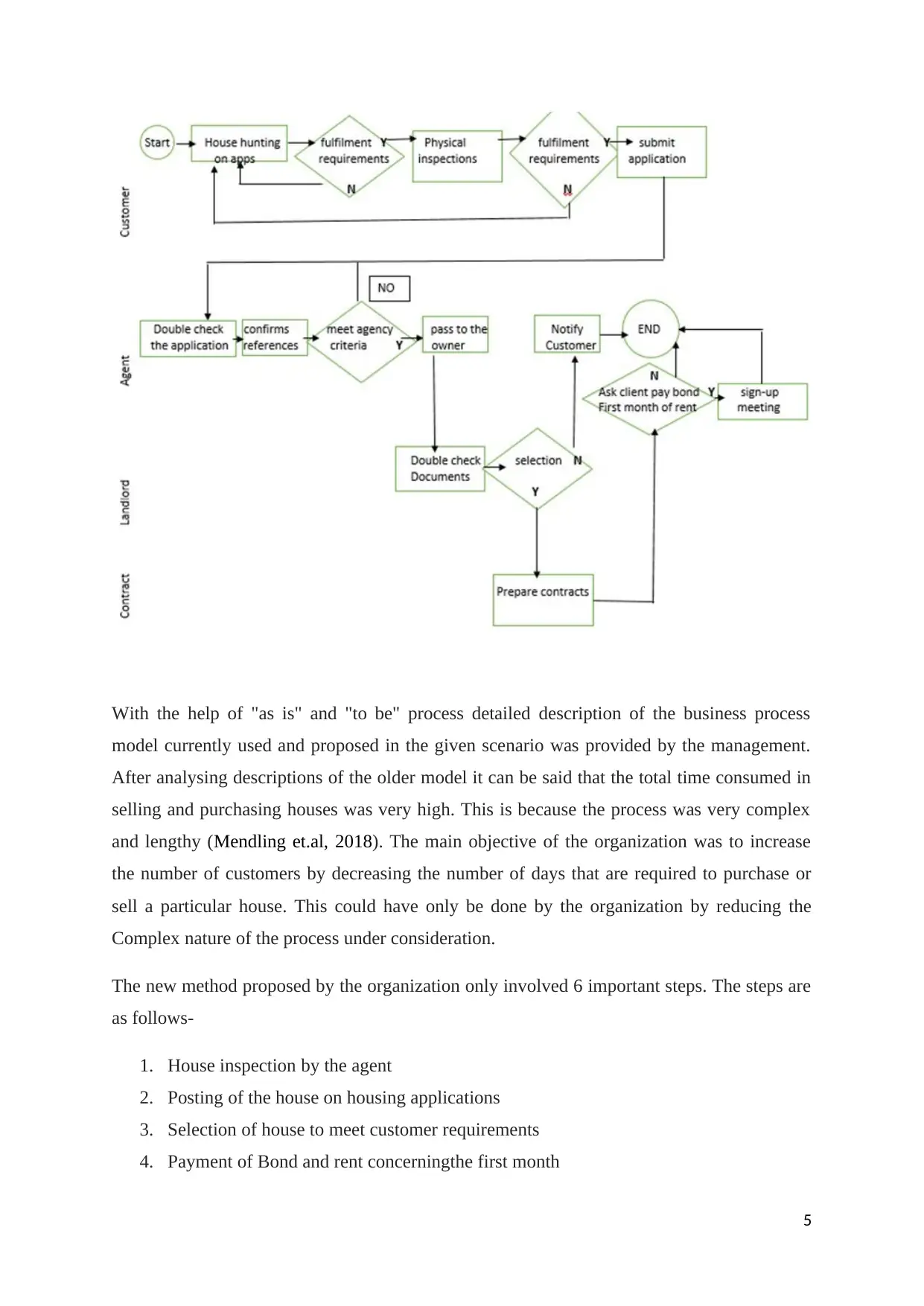
With the help of "as is" and "to be" process detailed description of the business process
model currently used and proposed in the given scenario was provided by the management.
After analysing descriptions of the older model it can be said that the total time consumed in
selling and purchasing houses was very high. This is because the process was very complex
and lengthy (Mendling et.al, 2018). The main objective of the organization was to increase
the number of customers by decreasing the number of days that are required to purchase or
sell a particular house. This could have only be done by the organization by reducing the
Complex nature of the process under consideration.
The new method proposed by the organization only involved 6 important steps. The steps are
as follows-
1. House inspection by the agent
2. Posting of the house on housing applications
3. Selection of house to meet customer requirements
4. Payment of Bond and rent concerningthe first month
5
model currently used and proposed in the given scenario was provided by the management.
After analysing descriptions of the older model it can be said that the total time consumed in
selling and purchasing houses was very high. This is because the process was very complex
and lengthy (Mendling et.al, 2018). The main objective of the organization was to increase
the number of customers by decreasing the number of days that are required to purchase or
sell a particular house. This could have only be done by the organization by reducing the
Complex nature of the process under consideration.
The new method proposed by the organization only involved 6 important steps. The steps are
as follows-
1. House inspection by the agent
2. Posting of the house on housing applications
3. Selection of house to meet customer requirements
4. Payment of Bond and rent concerningthe first month
5
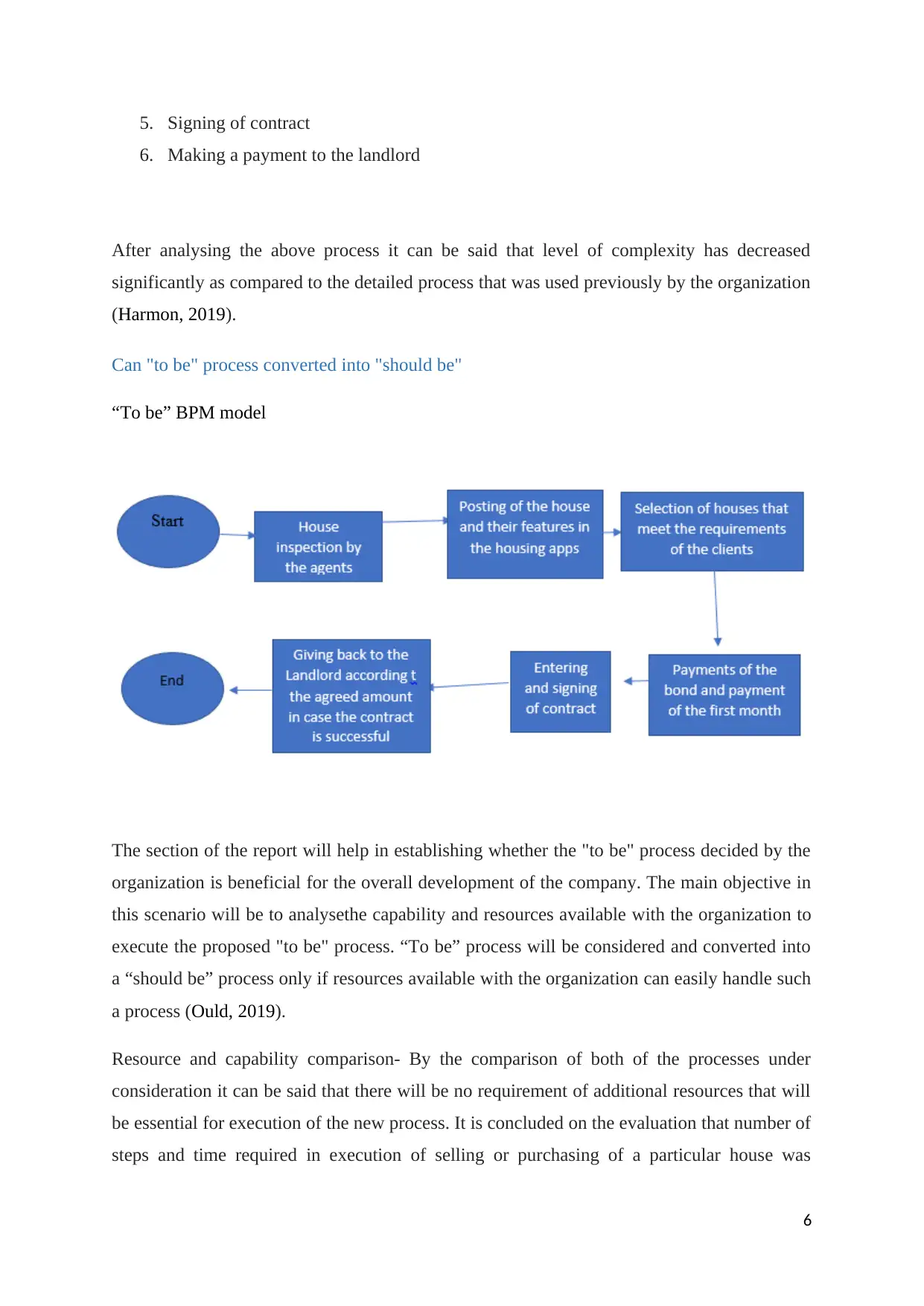
5. Signing of contract
6. Making a payment to the landlord
After analysing the above process it can be said that level of complexity has decreased
significantly as compared to the detailed process that was used previously by the organization
(Harmon, 2019).
Can "to be" process converted into "should be"
“To be” BPM model
The section of the report will help in establishing whether the "to be" process decided by the
organization is beneficial for the overall development of the company. The main objective in
this scenario will be to analysethe capability and resources available with the organization to
execute the proposed "to be" process. “To be” process will be considered and converted into
a “should be” process only if resources available with the organization can easily handle such
a process (Ould, 2019).
Resource and capability comparison- By the comparison of both of the processes under
consideration it can be said that there will be no requirement of additional resources that will
be essential for execution of the new process. It is concluded on the evaluation that number of
steps and time required in execution of selling or purchasing of a particular house was
6
6. Making a payment to the landlord
After analysing the above process it can be said that level of complexity has decreased
significantly as compared to the detailed process that was used previously by the organization
(Harmon, 2019).
Can "to be" process converted into "should be"
“To be” BPM model
The section of the report will help in establishing whether the "to be" process decided by the
organization is beneficial for the overall development of the company. The main objective in
this scenario will be to analysethe capability and resources available with the organization to
execute the proposed "to be" process. “To be” process will be considered and converted into
a “should be” process only if resources available with the organization can easily handle such
a process (Ould, 2019).
Resource and capability comparison- By the comparison of both of the processes under
consideration it can be said that there will be no requirement of additional resources that will
be essential for execution of the new process. It is concluded on the evaluation that number of
steps and time required in execution of selling or purchasing of a particular house was
6
⊘ This is a preview!⊘
Do you want full access?
Subscribe today to unlock all pages.

Trusted by 1+ million students worldwide
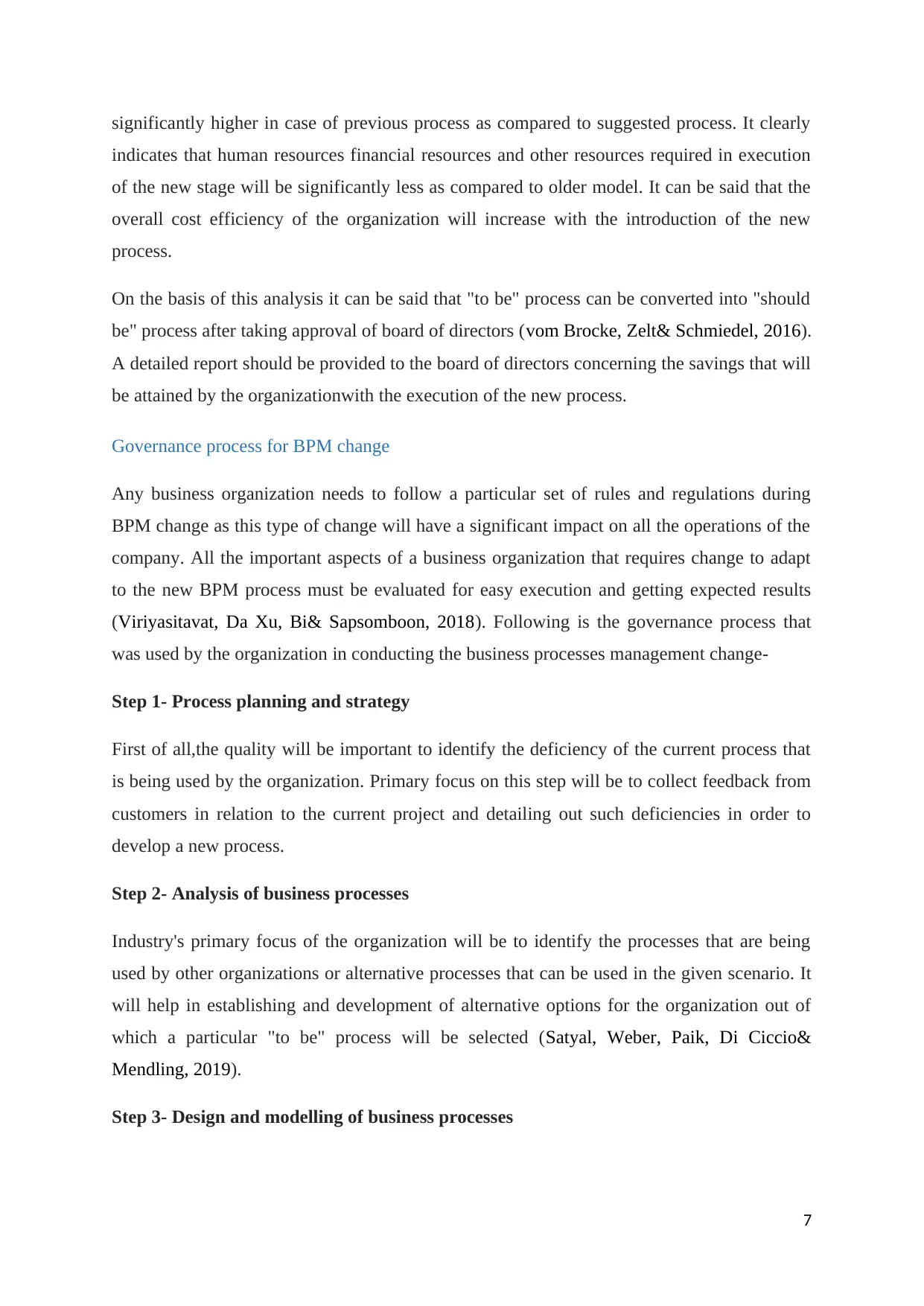
significantly higher in case of previous process as compared to suggested process. It clearly
indicates that human resources financial resources and other resources required in execution
of the new stage will be significantly less as compared to older model. It can be said that the
overall cost efficiency of the organization will increase with the introduction of the new
process.
On the basis of this analysis it can be said that "to be" process can be converted into "should
be" process after taking approval of board of directors (vom Brocke, Zelt& Schmiedel, 2016).
A detailed report should be provided to the board of directors concerning the savings that will
be attained by the organizationwith the execution of the new process.
Governance process for BPM change
Any business organization needs to follow a particular set of rules and regulations during
BPM change as this type of change will have a significant impact on all the operations of the
company. All the important aspects of a business organization that requires change to adapt
to the new BPM process must be evaluated for easy execution and getting expected results
(Viriyasitavat, Da Xu, Bi& Sapsomboon, 2018). Following is the governance process that
was used by the organization in conducting the business processes management change-
Step 1- Process planning and strategy
First of all,the quality will be important to identify the deficiency of the current process that
is being used by the organization. Primary focus on this step will be to collect feedback from
customers in relation to the current project and detailing out such deficiencies in order to
develop a new process.
Step 2- Analysis of business processes
Industry's primary focus of the organization will be to identify the processes that are being
used by other organizations or alternative processes that can be used in the given scenario. It
will help in establishing and development of alternative options for the organization out of
which a particular "to be" process will be selected (Satyal, Weber, Paik, Di Ciccio&
Mendling, 2019).
Step 3- Design and modelling of business processes
7
indicates that human resources financial resources and other resources required in execution
of the new stage will be significantly less as compared to older model. It can be said that the
overall cost efficiency of the organization will increase with the introduction of the new
process.
On the basis of this analysis it can be said that "to be" process can be converted into "should
be" process after taking approval of board of directors (vom Brocke, Zelt& Schmiedel, 2016).
A detailed report should be provided to the board of directors concerning the savings that will
be attained by the organizationwith the execution of the new process.
Governance process for BPM change
Any business organization needs to follow a particular set of rules and regulations during
BPM change as this type of change will have a significant impact on all the operations of the
company. All the important aspects of a business organization that requires change to adapt
to the new BPM process must be evaluated for easy execution and getting expected results
(Viriyasitavat, Da Xu, Bi& Sapsomboon, 2018). Following is the governance process that
was used by the organization in conducting the business processes management change-
Step 1- Process planning and strategy
First of all,the quality will be important to identify the deficiency of the current process that
is being used by the organization. Primary focus on this step will be to collect feedback from
customers in relation to the current project and detailing out such deficiencies in order to
develop a new process.
Step 2- Analysis of business processes
Industry's primary focus of the organization will be to identify the processes that are being
used by other organizations or alternative processes that can be used in the given scenario. It
will help in establishing and development of alternative options for the organization out of
which a particular "to be" process will be selected (Satyal, Weber, Paik, Di Ciccio&
Mendling, 2019).
Step 3- Design and modelling of business processes
7
Paraphrase This Document
Need a fresh take? Get an instant paraphrase of this document with our AI Paraphraser
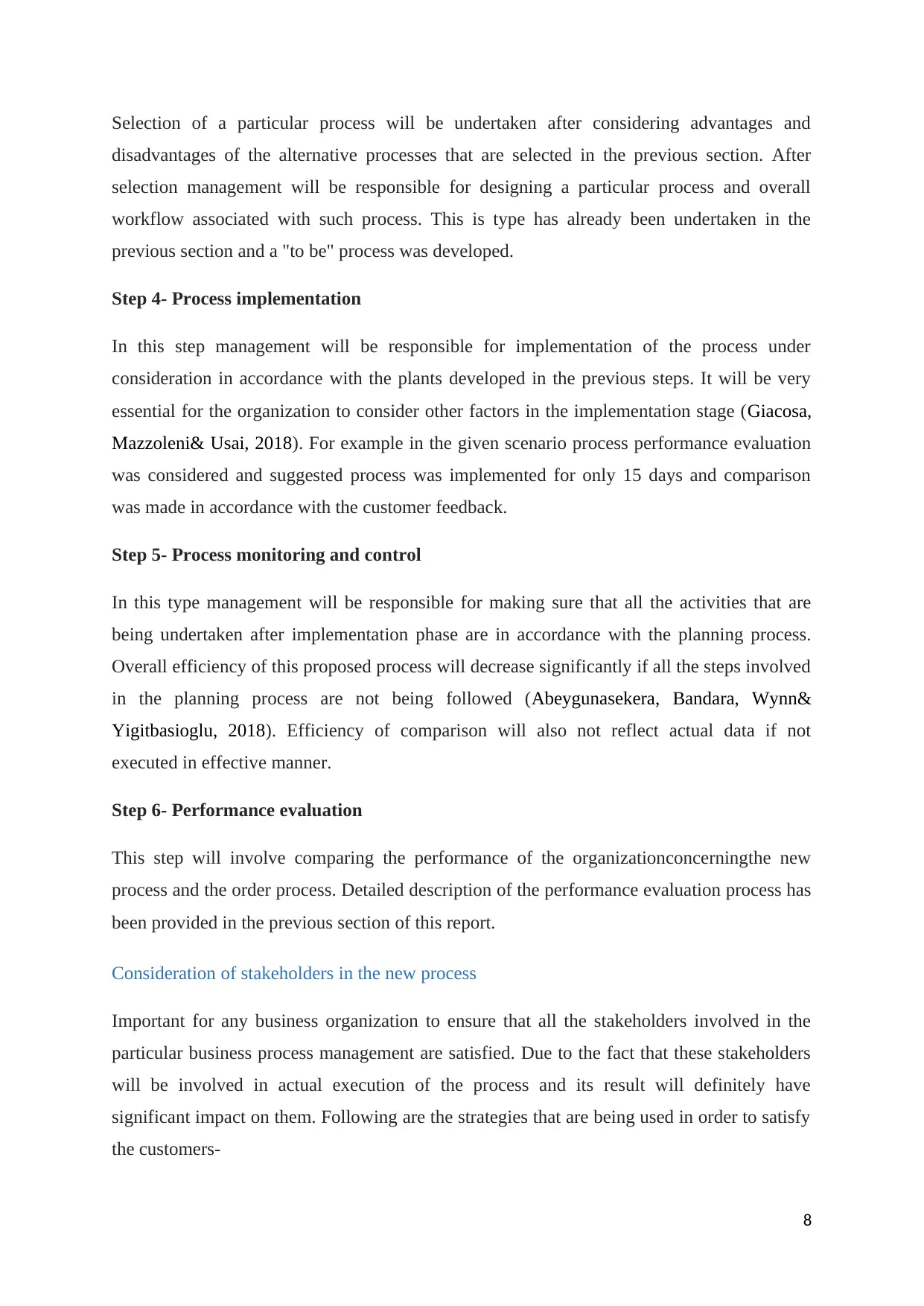
Selection of a particular process will be undertaken after considering advantages and
disadvantages of the alternative processes that are selected in the previous section. After
selection management will be responsible for designing a particular process and overall
workflow associated with such process. This is type has already been undertaken in the
previous section and a "to be" process was developed.
Step 4- Process implementation
In this step management will be responsible for implementation of the process under
consideration in accordance with the plants developed in the previous steps. It will be very
essential for the organization to consider other factors in the implementation stage (Giacosa,
Mazzoleni& Usai, 2018). For example in the given scenario process performance evaluation
was considered and suggested process was implemented for only 15 days and comparison
was made in accordance with the customer feedback.
Step 5- Process monitoring and control
In this type management will be responsible for making sure that all the activities that are
being undertaken after implementation phase are in accordance with the planning process.
Overall efficiency of this proposed process will decrease significantly if all the steps involved
in the planning process are not being followed (Abeygunasekera, Bandara, Wynn&
Yigitbasioglu, 2018). Efficiency of comparison will also not reflect actual data if not
executed in effective manner.
Step 6- Performance evaluation
This step will involve comparing the performance of the organizationconcerningthe new
process and the order process. Detailed description of the performance evaluation process has
been provided in the previous section of this report.
Consideration of stakeholders in the new process
Important for any business organization to ensure that all the stakeholders involved in the
particular business process management are satisfied. Due to the fact that these stakeholders
will be involved in actual execution of the process and its result will definitely have
significant impact on them. Following are the strategies that are being used in order to satisfy
the customers-
8
disadvantages of the alternative processes that are selected in the previous section. After
selection management will be responsible for designing a particular process and overall
workflow associated with such process. This is type has already been undertaken in the
previous section and a "to be" process was developed.
Step 4- Process implementation
In this step management will be responsible for implementation of the process under
consideration in accordance with the plants developed in the previous steps. It will be very
essential for the organization to consider other factors in the implementation stage (Giacosa,
Mazzoleni& Usai, 2018). For example in the given scenario process performance evaluation
was considered and suggested process was implemented for only 15 days and comparison
was made in accordance with the customer feedback.
Step 5- Process monitoring and control
In this type management will be responsible for making sure that all the activities that are
being undertaken after implementation phase are in accordance with the planning process.
Overall efficiency of this proposed process will decrease significantly if all the steps involved
in the planning process are not being followed (Abeygunasekera, Bandara, Wynn&
Yigitbasioglu, 2018). Efficiency of comparison will also not reflect actual data if not
executed in effective manner.
Step 6- Performance evaluation
This step will involve comparing the performance of the organizationconcerningthe new
process and the order process. Detailed description of the performance evaluation process has
been provided in the previous section of this report.
Consideration of stakeholders in the new process
Important for any business organization to ensure that all the stakeholders involved in the
particular business process management are satisfied. Due to the fact that these stakeholders
will be involved in actual execution of the process and its result will definitely have
significant impact on them. Following are the strategies that are being used in order to satisfy
the customers-
8
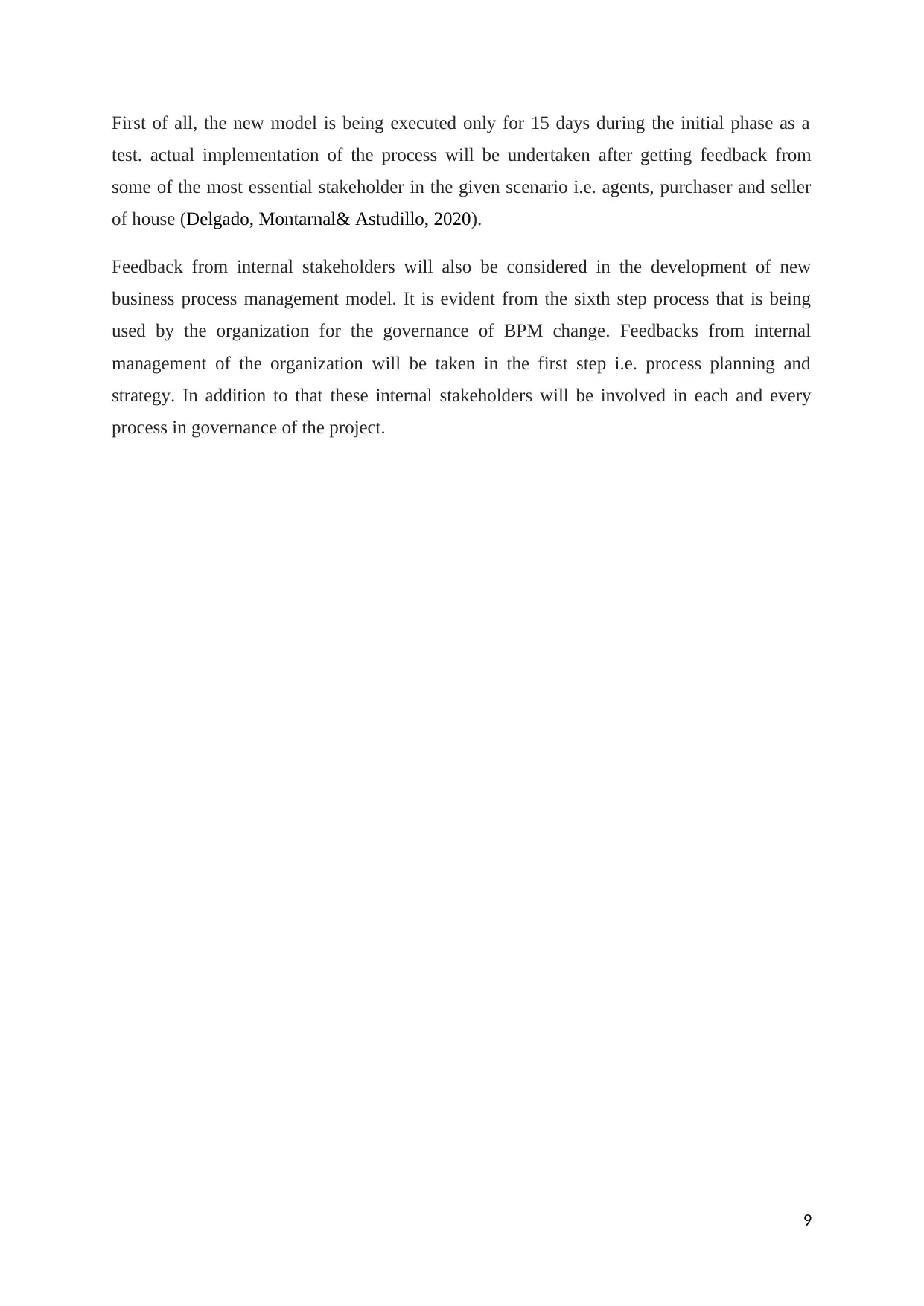
First of all, the new model is being executed only for 15 days during the initial phase as a
test. actual implementation of the process will be undertaken after getting feedback from
some of the most essential stakeholder in the given scenario i.e. agents, purchaser and seller
of house (Delgado, Montarnal& Astudillo, 2020).
Feedback from internal stakeholders will also be considered in the development of new
business process management model. It is evident from the sixth step process that is being
used by the organization for the governance of BPM change. Feedbacks from internal
management of the organization will be taken in the first step i.e. process planning and
strategy. In addition to that these internal stakeholders will be involved in each and every
process in governance of the project.
9
test. actual implementation of the process will be undertaken after getting feedback from
some of the most essential stakeholder in the given scenario i.e. agents, purchaser and seller
of house (Delgado, Montarnal& Astudillo, 2020).
Feedback from internal stakeholders will also be considered in the development of new
business process management model. It is evident from the sixth step process that is being
used by the organization for the governance of BPM change. Feedbacks from internal
management of the organization will be taken in the first step i.e. process planning and
strategy. In addition to that these internal stakeholders will be involved in each and every
process in governance of the project.
9
⊘ This is a preview!⊘
Do you want full access?
Subscribe today to unlock all pages.

Trusted by 1+ million students worldwide
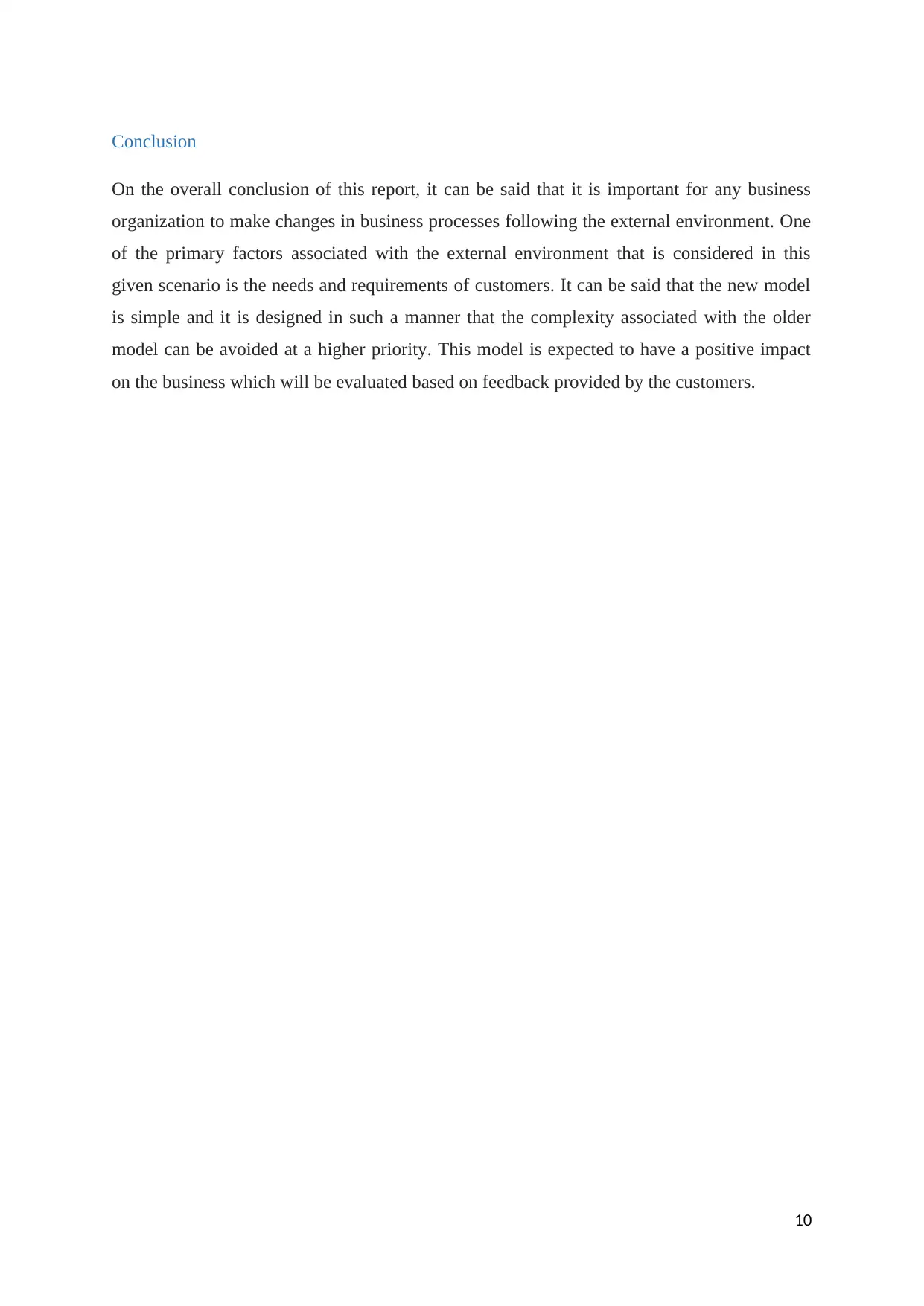
Conclusion
On the overall conclusion of this report, it can be said that it is important for any business
organization to make changes in business processes following the external environment. One
of the primary factors associated with the external environment that is considered in this
given scenario is the needs and requirements of customers. It can be said that the new model
is simple and it is designed in such a manner that the complexity associated with the older
model can be avoided at a higher priority. This model is expected to have a positive impact
on the business which will be evaluated based on feedback provided by the customers.
10
On the overall conclusion of this report, it can be said that it is important for any business
organization to make changes in business processes following the external environment. One
of the primary factors associated with the external environment that is considered in this
given scenario is the needs and requirements of customers. It can be said that the new model
is simple and it is designed in such a manner that the complexity associated with the older
model can be avoided at a higher priority. This model is expected to have a positive impact
on the business which will be evaluated based on feedback provided by the customers.
10
Paraphrase This Document
Need a fresh take? Get an instant paraphrase of this document with our AI Paraphraser
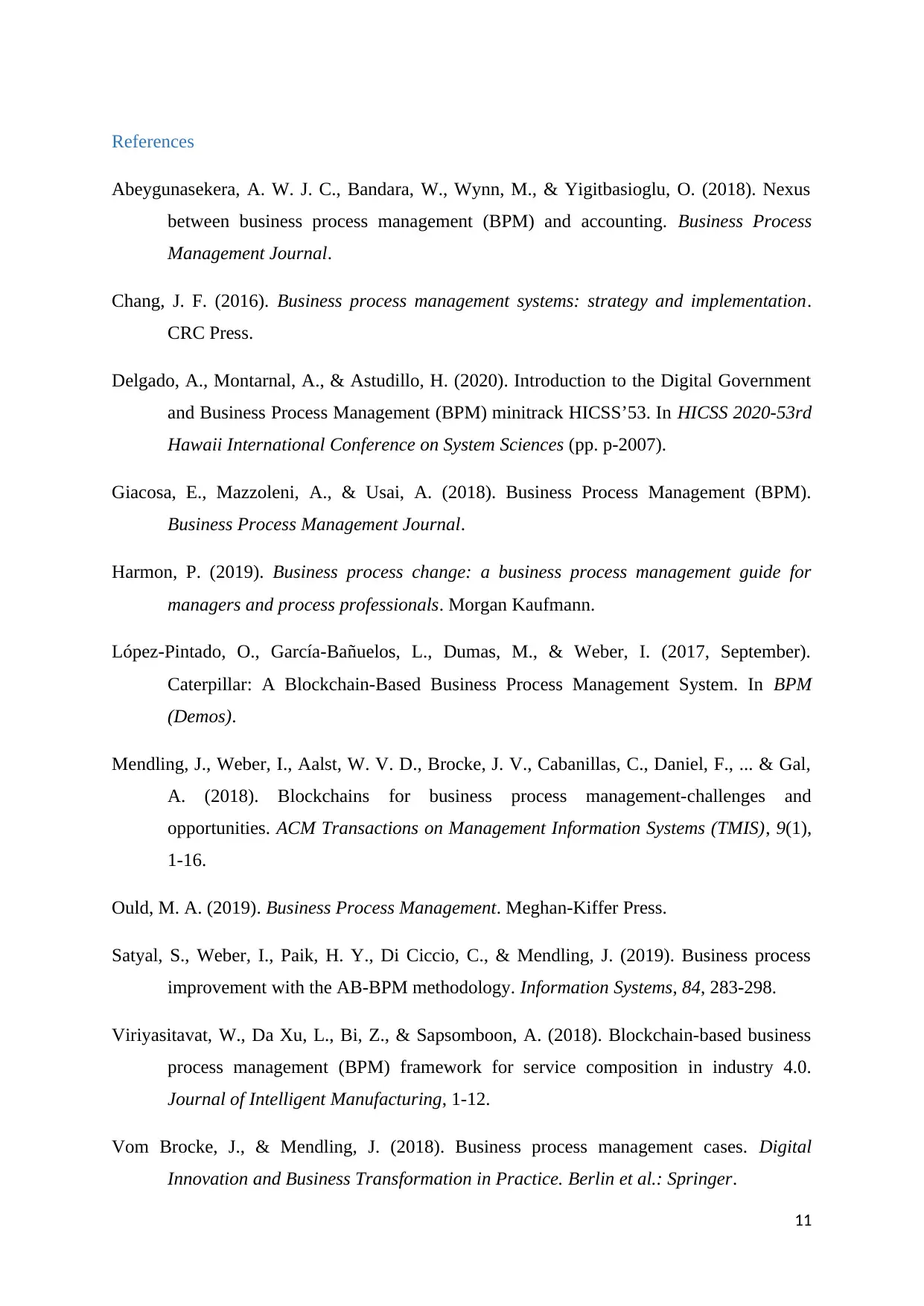
References
Abeygunasekera, A. W. J. C., Bandara, W., Wynn, M., & Yigitbasioglu, O. (2018). Nexus
between business process management (BPM) and accounting. Business Process
Management Journal.
Chang, J. F. (2016). Business process management systems: strategy and implementation.
CRC Press.
Delgado, A., Montarnal, A., & Astudillo, H. (2020). Introduction to the Digital Government
and Business Process Management (BPM) minitrack HICSS’53. In HICSS 2020-53rd
Hawaii International Conference on System Sciences (pp. p-2007).
Giacosa, E., Mazzoleni, A., & Usai, A. (2018). Business Process Management (BPM).
Business Process Management Journal.
Harmon, P. (2019). Business process change: a business process management guide for
managers and process professionals. Morgan Kaufmann.
López-Pintado, O., García-Bañuelos, L., Dumas, M., & Weber, I. (2017, September).
Caterpillar: A Blockchain-Based Business Process Management System. In BPM
(Demos).
Mendling, J., Weber, I., Aalst, W. V. D., Brocke, J. V., Cabanillas, C., Daniel, F., ... & Gal,
A. (2018). Blockchains for business process management-challenges and
opportunities. ACM Transactions on Management Information Systems (TMIS), 9(1),
1-16.
Ould, M. A. (2019). Business Process Management. Meghan-Kiffer Press.
Satyal, S., Weber, I., Paik, H. Y., Di Ciccio, C., & Mendling, J. (2019). Business process
improvement with the AB-BPM methodology. Information Systems, 84, 283-298.
Viriyasitavat, W., Da Xu, L., Bi, Z., & Sapsomboon, A. (2018). Blockchain-based business
process management (BPM) framework for service composition in industry 4.0.
Journal of Intelligent Manufacturing, 1-12.
Vom Brocke, J., & Mendling, J. (2018). Business process management cases. Digital
Innovation and Business Transformation in Practice. Berlin et al.: Springer.
11
Abeygunasekera, A. W. J. C., Bandara, W., Wynn, M., & Yigitbasioglu, O. (2018). Nexus
between business process management (BPM) and accounting. Business Process
Management Journal.
Chang, J. F. (2016). Business process management systems: strategy and implementation.
CRC Press.
Delgado, A., Montarnal, A., & Astudillo, H. (2020). Introduction to the Digital Government
and Business Process Management (BPM) minitrack HICSS’53. In HICSS 2020-53rd
Hawaii International Conference on System Sciences (pp. p-2007).
Giacosa, E., Mazzoleni, A., & Usai, A. (2018). Business Process Management (BPM).
Business Process Management Journal.
Harmon, P. (2019). Business process change: a business process management guide for
managers and process professionals. Morgan Kaufmann.
López-Pintado, O., García-Bañuelos, L., Dumas, M., & Weber, I. (2017, September).
Caterpillar: A Blockchain-Based Business Process Management System. In BPM
(Demos).
Mendling, J., Weber, I., Aalst, W. V. D., Brocke, J. V., Cabanillas, C., Daniel, F., ... & Gal,
A. (2018). Blockchains for business process management-challenges and
opportunities. ACM Transactions on Management Information Systems (TMIS), 9(1),
1-16.
Ould, M. A. (2019). Business Process Management. Meghan-Kiffer Press.
Satyal, S., Weber, I., Paik, H. Y., Di Ciccio, C., & Mendling, J. (2019). Business process
improvement with the AB-BPM methodology. Information Systems, 84, 283-298.
Viriyasitavat, W., Da Xu, L., Bi, Z., & Sapsomboon, A. (2018). Blockchain-based business
process management (BPM) framework for service composition in industry 4.0.
Journal of Intelligent Manufacturing, 1-12.
Vom Brocke, J., & Mendling, J. (2018). Business process management cases. Digital
Innovation and Business Transformation in Practice. Berlin et al.: Springer.
11

Vom Brocke, J., Zelt, S., & Schmiedel, T. (2016). On the role of context in business process
management. International Journal of Information Management, 36(3), 486-495.
12
management. International Journal of Information Management, 36(3), 486-495.
12
⊘ This is a preview!⊘
Do you want full access?
Subscribe today to unlock all pages.

Trusted by 1+ million students worldwide
1 out of 12
Related Documents
Your All-in-One AI-Powered Toolkit for Academic Success.
+13062052269
info@desklib.com
Available 24*7 on WhatsApp / Email
![[object Object]](/_next/static/media/star-bottom.7253800d.svg)
Unlock your academic potential
Copyright © 2020–2025 A2Z Services. All Rights Reserved. Developed and managed by ZUCOL.





